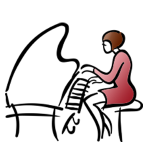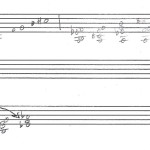Alto2 asks:
Um, Lucy, can you please ’splain what is a THEREMIN??? Why is it being featured on this program?
How remiss of me not to explain that important detail! I’m gonna answer these questions in reverse order, though, because the answer to #2 is short and sweet:
Why Theremin? Why not? 😉
More seriously, though — my good friend Scott Paulson, multi-instrumentalist, sound artist and all-around music impresario extraordinaire, plays the Theremin — that’s the main reason. His “legit” gig is playing oboe in the San Diego Chamber Orchestra, and while planning the current season, the conductor asked the orchestra members if any of them had any novel and interesting musical angles they’d like to include in the season. Scott suggested a Theremin concerto, and why not commission a living composer, while you’re at it? That was my lucky day! (I’m also shouldering the epic responsibility of being the only female composer on the orchestra’s season. This, sadly, is not an unusual state of affairs. Give it 50 or 100 years though — we’re taking over, watch out! 😛 )
So, what is this thing called Theremin, anyway?
 The Theremin is an early electronic instrument named for its inventor, the Russian physicist Léon Theremin, whose colorful and intrigue-filled life has been engagingly chronicled in the 1994 documentary Theremin – An Electronic Odyssey. The instrument uses two radio frequency oscillators to produce its sound: one controls volume and the other controls pitch. The volume and pitch are determined by the position of the player’s hands in relation to two corresponding antennae. Thus, it is the only instrument that you play without actually touching it. Which ain’t exactly easy!
The Theremin is an early electronic instrument named for its inventor, the Russian physicist Léon Theremin, whose colorful and intrigue-filled life has been engagingly chronicled in the 1994 documentary Theremin – An Electronic Odyssey. The instrument uses two radio frequency oscillators to produce its sound: one controls volume and the other controls pitch. The volume and pitch are determined by the position of the player’s hands in relation to two corresponding antennae. Thus, it is the only instrument that you play without actually touching it. Which ain’t exactly easy!
To the chagrin of many serious theremin players, the instrument is best known for its novelty and sci-fi applications; it has appeared in many film and television scores as the signal for when the aliens arrive or some other bizarre thing happens — The Day the Earth Stood Still is a classic example. Rock musicians have made use of it as well; Jimmy Page plays it in the live version of Led Zeppelin’s “Whole Lotta Love” for the film The Song Remains the Same. And the easiest way for most people to imagine what it sounds like is to think of the undulating line in the Beach Boys’ “Good Vibrations,” although that’s actually a Theremin-inspired instrument called an Electro-Theremin, a.k.a. Tannerin, which produces a similar sound but is played by sliding the fingers along a ribbon-like sensor — a slightly easier technique.
There seems to be some confusion as to whether the theme music from the original Star Trek series uses the Theremin or a woman’s voice. Sources I found indicate that it’s a voice singing that haunting melody ;), but it does sound really good on Theremin.
While writing my concerto, I decided to split the different between its “serious music” adherents and the novelty/sci-fi references that most people are familiar with. As Scott likes to say, it can be as beautiful and expressive as a cello (or the human voice, for that matter), so I gave it a chance to shine in that way. But I wasn’t about to pass up an opportunity to be a goofball as well and exploit its campy, humorous potential… life’s too short! 😀

If you enjoyed this post, would you consider…
Thanks — you make the world a better place! 🙂




I’m wondering if anybody has synthesized theremin plugins out there.
Probably. I’m just to lazy to search and am wondering what we’d use it for. I have tons of really great “out there” samples on my drum module. The band hears em and goes “cool” but we never move beyond that.
You are funny. I enjoy reading your writing very much, and am now feeling a little guilty for not leaving a tip!
Since I am somewhat familiar with the Theremin and the history of it, the thing about this blog entry that piqued my interest was your comment that “it is the only instrument that you play without actually touching it.” I thought surely that cannot be true, and it set all of the gears in my brain in motion. After wearing out a few teeth (on the gears, of course), by gosh I’m thinking you are right! I think even most rock musicians are touching their guitars (even if some of them aren’t really playing them). Which gets me to thinking (for some reason Milli Vanilli came to mind): does a singer actually touch his/her instrument when “playing.” Give that one some thought.
Well, too much think’n go’n on ’round here. Time to go for a “vanilli” latte.
scott — I use a Pro Tools plugin called Xpand! which has a fairly big bank of sounds (which you can combine ‘n’ customize), and it has a Theremin patch that’s not bad, though it’s all cheesified with reverb and a hard delay that you can’t get rid of. But I used it for my MIDI mock-up, and it gave a good approximation.
Mike — Thanks very much! As for guilt, just keep thinking along those lines — after all, you wouldn’t want the Lord to call me home, wouldja? 😉
The question of whether a singer touches his/her instrument crossed my mind as well. I decided that since the singer’s body *is* the instrument, they are touching it by definition. Just think of all the money they save not having to replace strings or key pads, not needing to buy a case or anything… makes me jealous… 😀
Thank you so much for posting this and helping in the efforts of “World Thereminization”!
There is nothing like the real thing! (even in the mega produced Elfman scores you can tell it’s not a real live theremin.)
Hope you’ve encouraged composers to seek out a thereminist and not just a synth patch. We are lucky to be living during something of a Theremin Renaissance.
More people are picking it up more than ever now, and some are getting really good at it.
Linda, you’ve helped us all with this work.
Now I am hoping for more Kernohan Theremin Pieces!